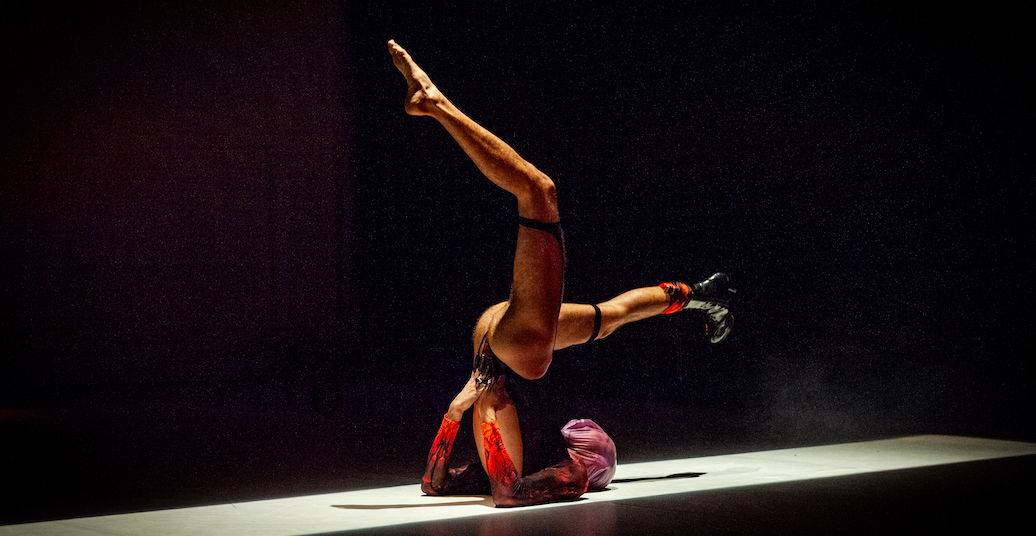“between,” the choreographic debut of Jules Petru Fricker (LEGZ) which ran from 11-13 November 2022 at DOCK 11, navigates with remarkable grace the spaces between artistic disciplines, queer performance practices, and narrations of the self—and births magical, touching moments in the process.
The discourse within the independent dance scene in Berlin about its own discipline is full of mystical half-truths. One of these is the romantic postulate that contemporary dance is not only especially adept at gathering people, but that it can create a special form of community in doing so. Countless memories of oppressive evenings of performance are just one of the reasons that this claim belongs in the archive of obsolete dance tropes. Now and then, though, there’s a moment that happily dissolves the usual skepticism. “between” from Jules Petru Fricker (LEGZ) is one such moment.
As Shiaz Legz, Jules Petru Fricker rose to YouTube fame in 2014 with their Conchita Wurst parody “Rise like a Penis”. Since then they perform at queer parties, festivals, and concerts under the drag name LEGZ. They have had lead roles in music videos and have performed in the theatre as well. “between” is Fricker’s first self-authored stage work after many years as a performance artist. Their many years of involvement in various queer communities are reflected by a look at the creative team, many of whom are well-known and established artists, which explains the confidence in the manipulation of the different media that the piece orchestrates.
It begins with a torso, lying on the empty stage, seemingly headless; all that the audience can see is a naked back. A single spotlight shines from the ceiling and illuminates the motionless body (light: Naia Burucoa), reminiscent of a queer Terminator that’s just come crashing to Earth. The body stirs, individual limbs twitch into view, and a text sounds out of nowhere that immediately establishes a few themes and terms that will be important for “between”: “…an embryo made of jelly-like substances, a creature… squeezed in-between dimensions, materialities, genders, colours, shapes, territories… in this spaceship coming from the ‘non-where’, while always heading towards the ‘else-where’…” (text: Oxi Pëng, Jules Petru Fricker).
A blackout, and then: the creature is suddenly in a shoulder stand, stretching arms and legs vertically towards the sky, creating an image that reminds me of a body frozen in the act of falling backwards. The creature’s fingers have black extensions (nails: Beauty Nails in Charlottenburg); one foot is naked, the other wears a Pleaser high heeled shoe laced up to the knee. To pulsing electronic sound, the being’s legs begin to move with increasing speed through the air (music: Aïsha Devi), before falling to the side, exhausted. Now we can see the transparent mask, which inflates with every breath, lengthening the face to the front. Then the being stands, pulls off the mask, takes a few tentative steps—the alien becomes a human.
In what is perhaps the central scene, Fricker sits in the audience and plays old videos from their childhood on a large projection screen. The clips are key moments in “between,” because it becomes clear that the movement material of the piece are taken from them—from Fricker’s childhood self, Julian. Are Jules’ movements re-enactments of Julian’s? Can we read the video clips of Julian as a pre-enactment of Jules? Or are the early movements perhaps repetitions of all the movements that are still to come in the future?
“between” takes up repeatedly and in different ways the motif of time travel: the piece puts past biographies and present biographies in relation. Aesthetically, the motif repeats through the piece’s situatedness in a science fiction universe, whereby subtle film references are also made—Fricker’s background as a video artist shows through here. And, finally, the performance makes constant reference to what is likely the most popular temporal figure of queer theory, the unmistakable “then and there” of the late José Esteban Muñoz. In his book Cruising Utopia he describes a queer utopia that lies in the future whose traces can nonetheless already be felt in the “here and now.” In a similar manner the time travel in “between” moves repeatedly back into the interstitial spaces of the present: “…in these cracks — worlds manifest themselves…” Fricker cries out evocatively, in one moment.
In the final scene, they dance through the entire theatre space, once again made alien by a tentacle mask (masks: Jochen Kronier). A door opens through which light rays stream in a virtuosically arranged flood (light design: Theresa Baumgartner). The bright gap that is pried open here is clearly one of the aforementioned cracks. And it’s here that my own personal miracle this evening takes place: in this moment, instead of slipping into a kitschy, empty gesture, “between” comes together. Because the scene makes no claims. Instead, it shows what was already there the entire time: the audience is the then and there in the here and now, a queer in-between—not simply qua its role as audience, but because it has gathered as a specific community, around the queer community of “between.” And as Julian, on the screen, turns in unison with Jules, on the stage, to the sounds of “Cruising” (saxophone: Bendik Giske), I imagine that for a brief moment, in spite of all our differences, a shared affect wafts through the audience: we have always been cruising, in some way or another, in search for the cracks — we have always been queer — queerness has always been here.
English translation by Cory Tamler
“between” by Jules Petru Fricker, also known under their alter ego LEGZ, was shown from 11-13 November 2022 at DOCK 11.




